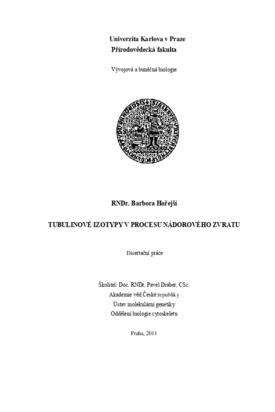Tubulinové izotypy v procesu nádorového zvratu
Tubuline isotypes in cancerogenesis
dizertační práce (OBHÁJENO)

Zobrazit/
Trvalý odkaz
http://hdl.handle.net/20.500.11956/47134Identifikátory
SIS: 84136
Kolekce
- Kvalifikační práce [19109]
Autor
Vedoucí práce
Oponent práce
Binarová, Pavla
Opatrný, Zdeněk
Fakulta / součást
Přírodovědecká fakulta
Obor
-
Katedra / ústav / klinika
Katedra buněčné biologie
Datum obhajoby
12. 9. 2011
Nakladatel
Univerzita Karlova, Přírodovědecká fakultaJazyk
Čeština
Známka
Prospěl/a
Klíčová slova (česky)
tubuliny, izotypy, glioblastomyKlíčová slova (anglicky)
tubulins. isotypes, glioblastomaOddělení biologie cytoskeletu se dlouhodobě zabývá studiem mikrotubulů, jejich dynamikou a molekulární charakterizací proteinů asociovaných s oganizačními centry mikrotubulů (MTOCs). Zvláště pak jejich klíčovým proteinem, g-tubulinem, který je nezbytný pro nukleaci mikrotubulů. Ukázali jsme, že g-tubulin je kromě centrozómů lokalizován na buněčných membránách (Macůrek et al., 2008), kinetochorových mikrotubulech rostlin (Dryková et al., 2003) a na marginálním svazku mikrotubulů v embryonálních kuřecích erytrocytech (Linhartová et al., 2002). g-Tubulin také vytváří komplexy s tyrozin kinázami, které by mohly regulovat nukleaci mikrotubulů (Sulimenko et al., 2006, Macůrek et al., 2008). V poslední době se ukazuje, že správná funkce centrozomálních proteinů je klíčová k udržení genové stability buňky. Je známo, že g-tubulin se účastní regulace buněčného cyklu (Vardy et al., 2002) a mohl by hrát roli při spouštění opravných mechanizmů při poškození DNA. V nedávné době byla prokázána jeho interakce s jadernými proteiny, jako je ATR kináza (Zhang et al., 2007) nebo proteinem Rad51 (Lesca et al., 2005). Proto se g-tubulin začíná spojovat s procesem nádorového zvratu. U nádorových buněk byly rovněž prokázány změny v expresi izotypů b-tubulinu (Katsetos et al., 2003). Zvláště zvýšená exprese bIII-tubulinu je dávána...
The long-term goal of the Laboratory of Biology of Cytoskeleton is to explain in molecular terms the role of microtubules in cellular processes and to characterize proteins associated with microtubules and its organizing centers (MTOCs). The main attention of our research is focused on -tubulin and its role in microtubule nucleation. We have shown previously that besides its localization on centrosomes, -tubulin is found on celullar membranes (Macůrek et al., 2008), plant kinetochores (Dryková et al., 2003) and marginal bend of embryonal chicken erytrocytes (Linhartová et al., 2002). g-Tubulin also interacts with protein tyrosine kinases, that can regulate microtubule nucleation (Sulimenko et al., 2006; Macůrek et al. 2008). There are growing evidence that centrosomal proteins can affect genetic stability of the cell. g-Tubulin is involved in the regulation of the cell cycle (Vardy et al., 2002) and can participate in activation of checkpoint mechanism controlling the integrity of DNA. Recently, it has been proved its interaction with nuclear protein ATR (Zhang et al., 2007) and Rad51 (Lesca et al., 2005). That's why g-tubulin has been connected with the process of cancerogenesis. Cancer cells also display the changes in expression of b-tubulin isotypes (Katsetos et al., 2003). Moreover, increased level of...
